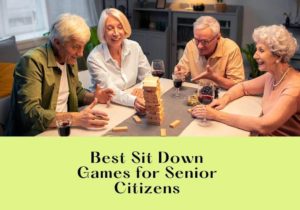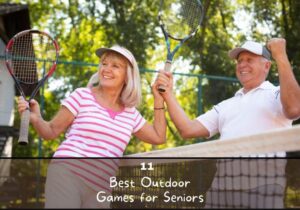Last Updated on: October 29, 2025 by Carlos P. Barry
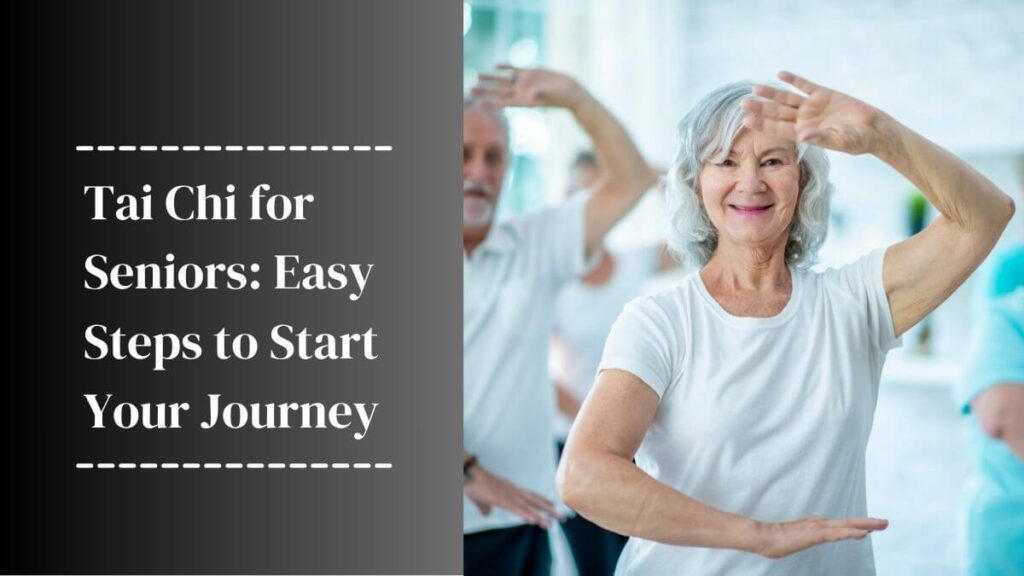
The older we get, the more imperative it is to remain active. But sometimes traditional workouts are intimidating — or too hard. This is where Tai Chi for seniors can help—a soft and slow form of exercise that both strengthens the body and relaxes the mind, helping older people to experience a more active and tranquil life. In this ultimate guide, we’re going to take a deep dive into what Tai Chi is, why it’s so great for seniors, the benefits of practicing, how to get started and specific tips for safe practice.
What is Tai Chi?
Tai Chi is a traditional, Chinese martial art form that features slow, flowing movements coupled with deep breathing and mindfulness. Developed many centuries ago, Tai Chi or Taijiquan was initially utilized as a martial art and practice but however has since turned out to be one of the most popular forms of health-promoting exercise.
Unlike high-intensity workouts, Tai Chi focuses on gentle, deliberate movements that improve flexibility, balance, and coordination without putting stress on the joints. It’s sometimes called “meditation in motion” because it emphasizes mental focus, calmness, and body awareness.
There are several versions of Tai Chi, among them Yang, Chen and Wu, but seniors derive the most benefit from simple routines that are designed for beginners. They focus on safety, ease of learning and health rather than martial applications.
Why Tai Chi is Ideal for Seniors
Tai Chi Strikes a Balance of Physical, Emotional and Mental Well Being. Here’s why seniors love it:
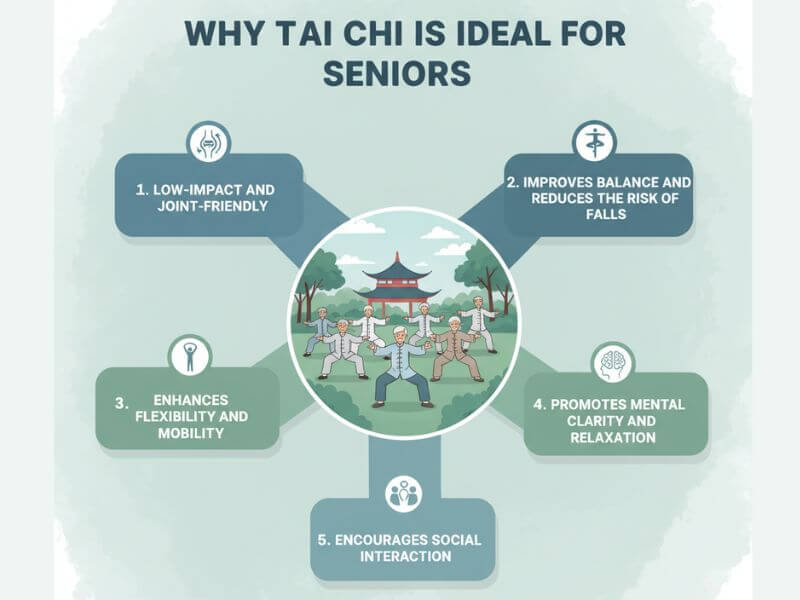
1. Low-Impact and Joint-Friendly
Tai Chi can be a safe form of exercise for the elderly, including those who suffer from arthritis, joint pain or limited physical functioning. The slow, controlled movements it entails minimizes risk of injury and contributes towards building strength as well as improving flexibility.
2. But it does improve balance and reduce the risk of falls
Among seniors, one of the most significant health concerns is falling. Tai Chi is known to improve balance, posture and coordination skill – these functions are important in reducing the risk of falling which heavily affects independence.
3. Enhances Flexibility and Mobility
Tai Chi involves gradual stretching and opening of muscles and joints — imperative for avoiding a stiff back while walking, bending or reaching.
4. Promotes Mental Clarity and Relaxation
Tai Chi involves meditation and deep breathing, which can be used to decrease stress, improve concentration, and enhance mood. It’s a natural cure for anxiety and mild depression.”
5. Encourages Social Interaction
Many seniors take Tai Chi in community classes or through an online class. This integration keeps loneliness at bay and motivates participants.
Check out our post: ‘Chair Yoga for Seniors: 7 Gentle & Safe Yoga Poses for Elderly’
Health benefits of Tai chi for elderly
1. Physical Benefits
- Builds Muscle: The regular practice tones lower body AND core muscles – and improved muscle tone aids in better posture and balance.
- Enhances Posture and Alignment: Slow movements encourage you to move correctly, which eases discomfort and lessens fatigue.
- Supports Heart Health: As mild as Tai Chi is, it can help to encourage heart health and better circulation with regular practice.
2. Mental Benefits
- Alleviates Stress and Anxiety: By practicing conscious movements with controlled breathing, one can achieve a sense of tranquility and peace.
- Sharpens the Mind: Tai Chi can improve focus, memory, and cognitive function.
- Improves Mood: Seniors may feel more resilient and upbeat.
3. Social Benefits
- Promotes Community: Group sessions bring you together with sympathetic peers.
- Promotes Regularity: The more you have people to relate in the way you are feeling either your pain or happiness, the higher level of consistency you can maintain.
Check out our post: The Unique Activities for Seniors to Keep Them Active
How to Begin Tai Chi for Seniors
You don’t need any special competences to begin Tai Chi, or expensive equipment. Here’s how seniors can get started safely and successfully:
1. Choose the Right Class
- In Your Area: A number of community centers, gyms and senior centers around the country offer Tai Chi classes for beginners.
- Online Classes: Online tutorials and Zoom classes are convenient for people who cannot leave home or have trouble with transportation.
2. Wear Comfortable Clothing
Choose comfortable, loose clothing and supportive shoes. This allows for better movement and stability. Avoid heavy or tight clothes.
3. Safety First
- Visit your doctor before starting, especially if you have injuries or long-term conditions.
- Start off slow. Don’t try to do the entire movement pattern at once.
- Hold onto a chair or wall if balancing is a problem.
4. Warm-Up Exercises
Begin by stretching, rolling your shoulders and rotating your ankles to warm up for Tai Chi movements. This will help to avoid stress and also promote good flexibility.
Tai Chi for Seniors: Easy to Follow Basic Movements
Here are a few gentle Tai Chi movement seniors just beginning can try:
1. Parting the Horse’s Mane
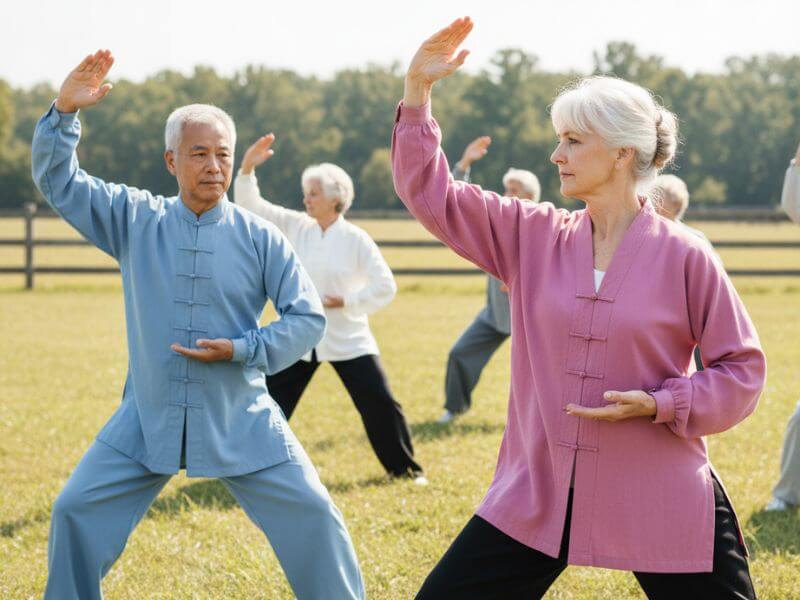
- Now side step with one foot as you shift your weight.
- Part your hands slowly, with a gentle undulating motion as if you were parting an invisible mane.
- Improves balance and coordination.
2. Wave Hands Like Clouds
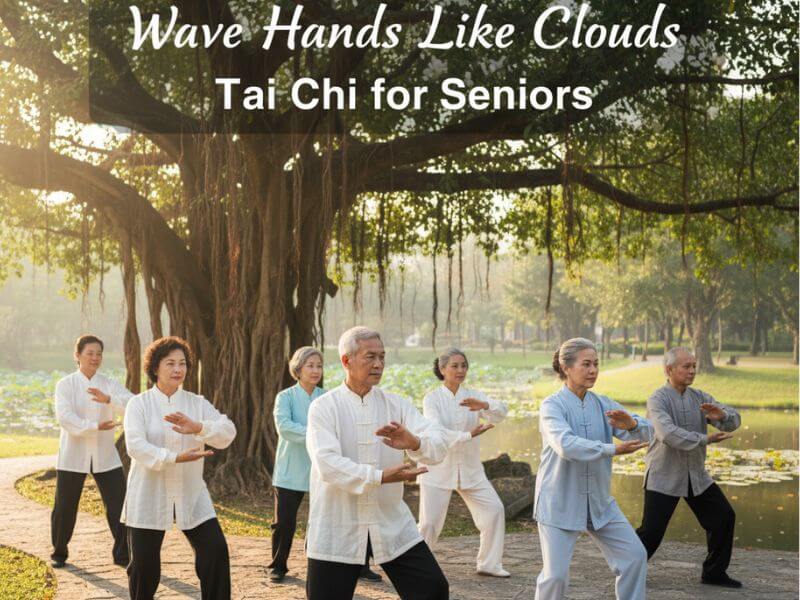
- Rock to the left and right while swaying your arms in clouds like circles.
- Improves body’s fluid movement as well as upper-body freedom and relaxation.
3. Golden Rooster Stands on One Leg
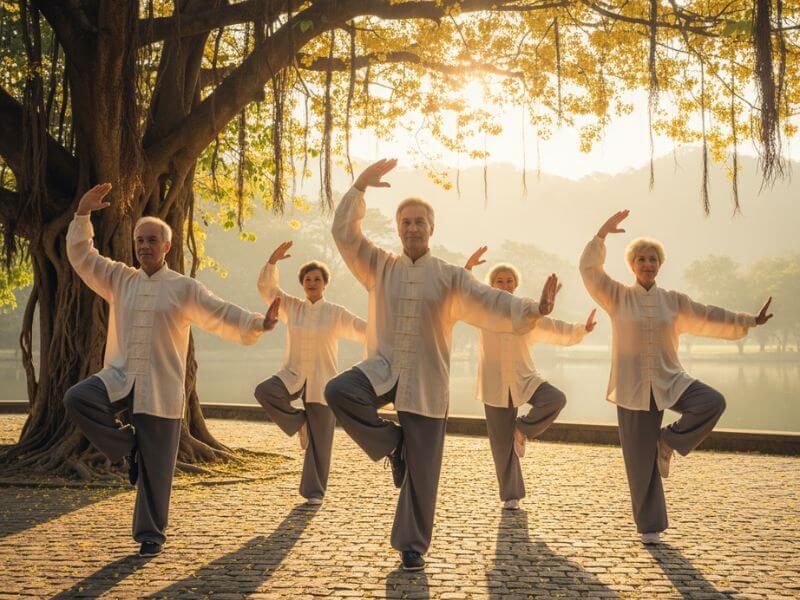
- Stand tall, lifting one leg slowly while balancing.
- Helps strengthen the legs and core while improving balance.
For safety, seniors should begin with a few repetitions and increase volume as strength and confidence grows. Form can be polished by watching video demonstrations.
What Is The Frequency Seniors Should Practice Tai Chi?
Consistency is key. Experts recommend:
- Frequency: 3–5 times per week
- Duration: 20–30 minutes per session
- Focus: Movement quality and mechanics > speed or intensity
Even fifteen minute spurts per day can result in increased balance, flexibility and mental clarity.
Tips for Staying Motivated
- Be Realistic: Focus on small, achievable goals, like improving balance or practicing a new movement.
- Community: Find accountability and motivation by taking group classes or joining an online forum.
- Keep Track of Gains: Use a journal or apps to record your progress in strength, flexibility, or stress levels.
- Celebrate Accomplishments: Recognize your successes, even small ones, as they build momentum and confidence.
Precautions and Safety Tips
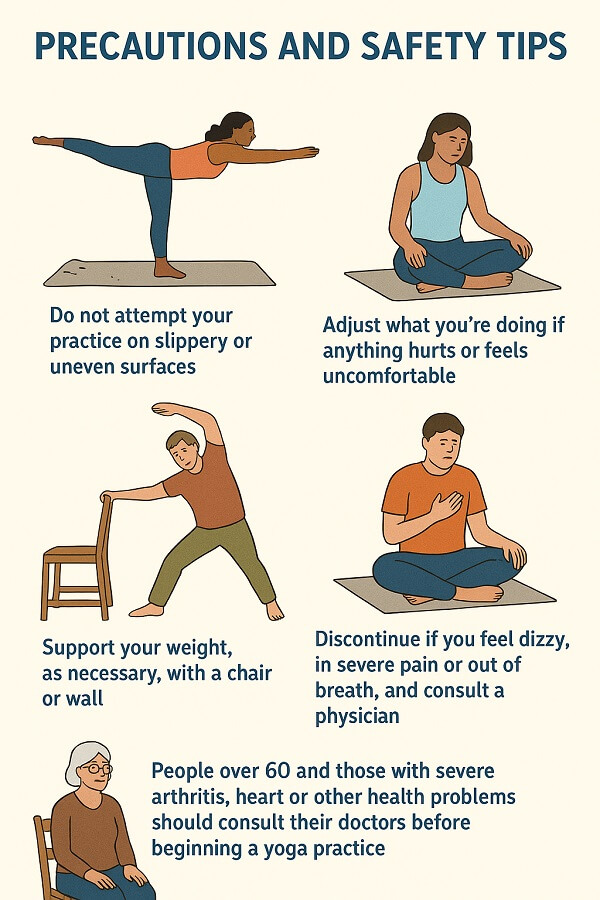
- Do not attempt your practice on slippery or uneven surfaces.
- Adjust what you’re doing if anything hurts or feels uncomfortable.
- Support your weight, as necessary, with a chair or wall.
- Discontinue if you feel dizzy, in severe pain or out of breath, and consult a physician.
- People over 60 and those with severe arthritis, heart or other health problems should consult their doctors before beginning a yoga practice
Frequently Asked Questions (FAQs)
Q1: Is Tai Chi appropriate for older people with arthritis?
Yes! Tai Chi is low-impact and gentle on the joints. Movements can be modified without compromising health benefits and may help reduce strain.
Q2: Can Tai Chi be an effective method for preventing falls?
Absolutely. Tai Chi enhances balance, coordination and lower-body strength, all factors that help reduce falls.
Q3: Is any special equipment required to do Tai Chi?
No special equipment is needed. A comfortable outfit, some shoes you can stand and lean on (or sit), along with a chair for using it as a prop, are all that’s required.
Q4: Can Tai Chi be good for stress and anxiety?
Yes. Its combination of slow movement, deep breathing and mindfulness is meant to relax people while clearing their minds.
Q5: How much time does it take to see results from doing Tai Chi?
Millions of older adults find balance, flexibility and a better frame of mind through regular practice. Prollonged Effects continue developing for months.
For seniors, Tai Chi is not just an invigorating low-impact workout; it’s a holistic practice that strengthens the body, calms the mind and nourishes the spirit. Whether you are seeking to enhance balance, improve flexibility, reduce stress or make new friends, Tai Chi is a safe and enjoyable way to reach your goal.
Getting started is easy, she said: Find a beginner-friendly class, practice regularly and pay attention to what your body needs. If you do it every day, soon, you’ll experience increased physical strength, enhanced mental clarity and heightened well-being.
Start here, today and change your life with Tai Chi for seniors. Your body—and mind—will thank you.
YOU MIGHT ALSO LIKE :
*Chair Yoga for Seniors: 7 Gentle & Safe Yoga Poses for Elderly
*15 Unique Activities for Seniors to Keep Them Active and Engaged
*11 Best Outdoor Games for Seniors: Engage the Mind & Body


